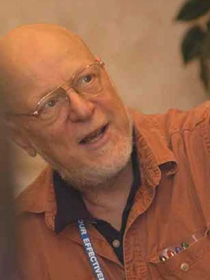
In recognition of outstanding contributions for over 45 years in the field of software testing, his key role in the design and implementation of the first multiprogramming operating system, his contributions to the NASA Mercury Program, and his continuing efforts to improve the problem solving process in the world of software development and testing, the School of Computing of the University of Nebraska–Lincoln proudly inducts Dr. Jerry Weinberg into the Nebraska Hall of Computing.
Gerald M. Weinberg, a 1955 graduate of the University of Nebraska–Lincoln, developed the first multi-programmed operating system for NASA’s Project Mercury and is a world-recognized expert on software development and testing. He is a gifted author of 40 books and more than 400 articles.
His most well-known books are The Psychology of Computer Programming and Introduction to General Systems Thinking both of which are considered to be classics in the field. The latter is related to the field of work of Jay Forrester another member of the Nebraska Hall of Computing.
Remembering his experiences at Nebraska, Weinberg says:
I did physics in Brace and spent a lot of time rummaging in the attic among 19th Century physics experiments. I did my astronomy on the roof of Ferguson which presaged my work in NASA's Space program.
As an undergraduate, I had the honor of being the first "computer" on the University of Nebraska–Lincoln campus. That was my job title in the Physics Department. I used a mechanical Friden, pencil, paper, and especially erasers, to invert 10x10 matrices for researchers in the department. There never was another computer on campus during my years there.
I became a physics teaching assistant as a junior, and graduated third in my class with highest distinction in physics and English. My other two majors were mathematics and philosophy.
I was elected to Sigma Xi, Phi Beta Kappa, and Pi Mu Epsilon, and took my National Science Foundation Fellowship to Berkeley, where I still found no computers. I went to work for IBM so I could finally get my hands on a computer, the first one in San Francisco.
With IBM, I was a member of the team that built the world's first operating system, then came onto NASA's Mercury Project as the architect of the space tracking system which was built around the world's first multi-programmed operating system.
I then took my Ph.D. from Michigan in Communication Sciences and initiated the field of human-computer interaction with my book, The Psychology of Computer Programming.
I returned to Lincoln around 1970, when my wife Dani took a position in the anthropology department. I was an adjunct professor in Computer Science and also participated with Dani in the ADAPT program for experiential learning.
M.J. Buist and G.M. Weinberg, “Ballistic Missile and Space Technology”, 1, pp. 435-445. (Proceedings of the Fifth Symposium on Ballistic Missile and Space Technology, August, 1960), Academic Press, 1960.
Weinberg, Gerald M. An Introduction to General Systems Thinking (Silver Anniversary Edition), New York NY: Dorset House, 1998.
Weinberg, Gerald M. The Psychology of Computer Programming: Silver Anniversary Edition, New York NY: Dorset House, 2001.